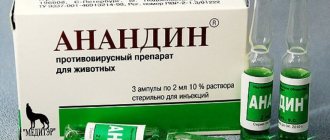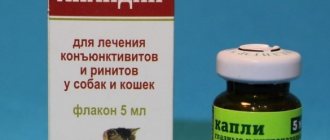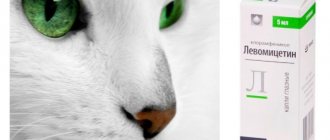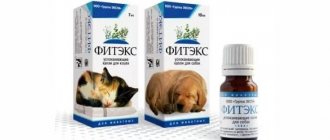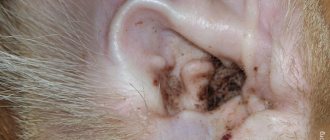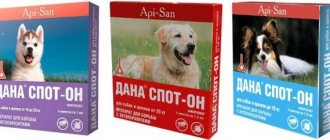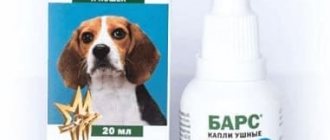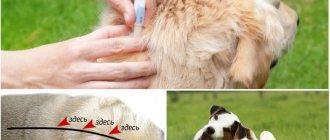Any illness in a pet causes anxiety and confusion among owners - what medications can be used to treat a pet? Are medications from a human medicine cabinet suitable for dogs? It would seem that both animals and their owners are living beings, which means that the treatment of diseases can be the same.
However, in practice, it is not always possible to treat four-legged friends with the means that people use; more often than not, it is even harmful to animals. In particular, we will consider the use of such a common drug as Albucid for the treatment of eye diseases in dogs. Is it possible or still not possible?
Is it possible?
First, let's get acquainted with what Albucid himself is. Another name for these eye drops is sodium sulfacyl. The main component of their composition is sulfacetamide. Available in small bottles of 5 or 10 ml.
Albucid is used as an antibacterial and bacteriostatic agent for conjunctivitis, purulent ulcers on the cornea, blepharitis, viral pathologies, and foreign particles getting into the eyes.
There is probably practically no person, neither an adult nor a child, who has not experienced treatment with Albucid at least once in his life. But are these drops, which are excellent at treating human diseases, suitable for dripping into dog eyes?
Animals are susceptible to the same diseases as people, but experienced veterinarians and owners who have encountered eye problems in dogs unanimously state that sodium sulfacyl is strictly contraindicated for dogs.
Signs of eye disease in dogs
It is quite difficult to protect your pet from injuries and inflammatory processes resulting from pathogenic microflora entering the mucous membrane of the eye. But regular care, use of special means and monitoring the condition of the visual organs is a feasible task. There are a number of characteristic signs that allow the owner to suspect a dog has an eye disease. It is often impossible to make a diagnosis on your own. But careful observation of the dog’s eyes and identification of alarming signs will allow you to promptly seek qualified help from a veterinary clinic.
Squinting
If your dog develops the habit of squinting one or both eyes, you should immediately take it to the vet. This behavior can be a symptom of a wide range of diseases, such as conjunctivitis or corneal erosion. It is quite difficult to detect corneal erosion at the initial stage of the pathological process. But the habit of squinting your eyes can become exactly that life-saving symptom that will allow you to diagnose the disease in time. Lack of timely treatment can lead to clouding of the cornea, and this is a direct path to partial or complete loss of vision.
The cause of corneal erosion may be:
- an inflammatory process that develops as a result of the ingress of pathogenic microflora;
- allergic conjunctivitis;
- corneal injuries;
- insufficient production of tear secretion, which leads to the development of dry eye syndrome.
If the owner ignores the characteristic squinting of the pet, then corneal erosion can develop into an ulcer within a short period of time. Experiencing pain and discomfort, the dog involuntarily squints the affected eye.
Squinting may be a sign of photophobia not associated with visual pathology. Photophobia can be observed in such dangerous diseases as canine distemper and rabies. Therefore, the owner should not ignore this seemingly insignificant symptom.
Redness or other discoloration of the conjunctiva
The reason for the appearance of a reddish tint in the mucous membrane of the dog’s eyes can be:
- allergic reaction. It can develop on food, dust, pollen of certain types of plants, medications, hair or feathers of pets, chemical reagents used by the owner for cleaning the house;
- pathological processes of the organs of vision (conjunctivitis, keratitis and many others);
- injuries resulting from physical, chemical or thermal exposure.
The owner should pay attention to the dog’s health even if the animal’s conjunctiva is too pale, yellowish or bluish. This is one of the signs of diseases not related to the eyes. Yellowness of the mucous membranes can be a sign of babesiosis, blueness can be a sign of problems with the cardiorespiratory system. The most alarming sign is the “porcelain pallor” of the mucous membranes. This symptom indicates acute blood loss, severe anemia, or other life-threatening conditions. You should consult a doctor immediately!
Discharge of pus
The appearance of purulent discharge is a serious sign of eye disease. The owner needs to observe the dog and not confuse mucus and pus. The first appears when a speck or small foreign body gets into the eye. At the same time, a tear secretion begins to be actively produced, which envelops and naturally removes the speck.
Why not?
Animals must be treated strictly with veterinary medications. It is important to note that it is prohibited to use Albucid, used in pediatric ophthalmology, to treat pets.
Some owners do not go into detail about the differences between drugs for humans and animals or simply want to save money, since drugs for animals are more expensive, but thereby cause more harm to their pets.
Albucid has a merciless effect on dog eyes, causing extreme burning, to the point that it can burn the cornea. In a milder case, so to speak, the drug causes chronic conjunctivitis.
Review of the best eye drops for all dogs
One of the most commonly used medications for keeping pets is eye drops for dogs. And this is quite understandable. For our four-legged friends, eyes are more than just an organ of vision. It is also a “tool” for communicating with each other, with its owner. This is an indicator of the dog's health.
Various discharge from the eyes, their swelling, inflammation and other changes can indicate not only their infection, but also more serious diseases of the body. Therefore, caring owners always carefully monitor the condition of their pets’ eyes and will never ignore any changes in them. If your pet’s eyes are red and constantly watery, or, even worse, fester, he has lost his visual acuity, or his eyes just need to be washed, drops can always help. What do you need to know about them?
Pregnant, lactating and puppies
Important! The use of Albucid is completely unacceptable when treating puppies, pregnant or lactating dogs. It is worth considering that small puppies and dogs expecting or nursing offspring are most vulnerable to the effects of both infections and medications.
Even veterinary medications must be carefully selected for this category of dogs, not to mention the harm that medication not intended for animals can cause.
How to use the drug correctly
How to put Levomycetin in the eyes of a cat? After visiting the veterinarian and prescribing the medication, you must read the instructions for use. After all, the guarantee of an animal’s health and the effectiveness of treatment depend not only on a well-chosen product, but also on its correct use.
There is no need to worry that your pet will be in pain, because the procedure for dropping Levomycetin into the eyes of a cat is painless. It can only cause discomfort. To carry it out correctly, you need to take the animal on your lap. If the pet breaks out, it should be calmed and stroked. It is advisable for the cat to sit with its back to the owner. In this position, she will not see the bottle and will be less afraid.
Before the procedure, you need to wash the hair around the eyes with a damp swab dipped in boiled water. The eyes, cleared of purulent discharge, should be carefully opened, pulling back the lower eyelid, and the cat should be dripped with Levomycetin. In this case, the animal may begin to twitch and break free. It is best to hold your pet in your arms for a few minutes after instillation, and do not let him scratch or wash his eyes. The medicine may sting your eyelids a little. Treatment must be repeated according to the veterinarian's instructions.
Breed characteristics
Many dogs of all breeds have eye diseases. However, some breeds that have structural features of the visual organs are more at risk than others of encountering this very unpleasant problem.
Excessive lacrimation and various discharges have been bothering dogs of the following breeds almost from the first days of life:
- breeds with drooping eyelids, such as spaniels, sharpeis, mastiffs, basset hounds;
- dogs with bulging eyes, for example, Chihuahuas, Pekingese, pugs;
- those with long hair, for example, lap dogs, poodles, Yorkshire terriers, Afghan hounds, collies;
- Brachycephalic dogs, for example, boxers, bulldogs, Pomeranians.
Older dogs of various breeds suffer from hazy corneas due to insufficient tear fluid. With this disease, additional discomfort for the dog is caused by purulent discharge and chronic conjunctivitis.
Contraindications and side effects
Only a veterinarian can prescribe a drug for the treatment of vision organs; Levomycetin eye drops for cats are no exception. Self-diagnosis at home can cause various complications. A contraindication to the use of the product is an allergy to the substances included in the composition, as well as chronic liver and kidney diseases.
Side effects when treating cats with Levomycetin are extremely rare. But still, in some situations, it can cause changes in the pet’s blood pressure, stomatitis, digestive disorders and enterocolitis. If suspicious signs occur, therapy should be stopped.
What to replace it with?
In pharmacies that offer medications for animals or pet stores, you can purchase special solutions and drops intended for the treatment of eye diseases in dogs.
The most well-known and effective drugs are:
" Diamond Eyes " - drops. They are used for redness of the mucous membranes of the eyes or for the prevention of eye diseases. You can treat your eyes with a cotton swab with the solution applied or drop it into your eyes.
" Ofto-lavas " is a sterile solution for washing the eyes from pus, sticky exudate, crusts around the eyes. Has a cleansing, soothing and softening effect.
" Oftal " - lotion and drops. Used to cleanse the eyes and hair around them.
“ Tear stain remover ” is a lotion for removing tear tracks and saliva from animal fur.
Chamomile decoction is used to wash the eyes during purulence.
" Levomycetin " - eye drops, antibiotic. Used for severe infections.
" Tsiprovet " - drops, antibiotic. Used to treat conjunctivitis, other eye inflammations, viruses, infections due to eye injuries.
" Tobrex " - drops, antibiotic. Prescribed for the treatment of inflammation and eye infections.
“ Tetracycline eye ointment ” is an ointment containing an antibiotic. Apply to the lower eyelid for inflammation, infections, and eye injuries.
" Solcoseryl " - eye gel. Restores skin and heals dry wounds.
" Laprikan ", " Bars " - drops, antiseptics. Used for conjunctivitis and keratitis of unknown etiology.
" Desacite " - antimicrobial drops. They have a regenerating effect.
" Iris " - drops with antibacterial properties.
" Maksidin " - drops with antiviral and immunostimulating effects.
" Optimmune " - eye ointment. Used to treat diseases of autoimmune etiology. Helps restore natural tear production.
" Alphagan " - drops. Prescribed for the treatment of glaucoma.
" Combigan " - eye drops. Used as a drug against glaucoma.
Important! Never self-medicate based on reviews on the Internet and friends! Each drug must be prescribed strictly by a specialist!
Levomycetin
COMPOSITION AND RELEASE FORM
The drug contains chloramphenicol as an active substance - a synthetic antibiotic identical to the natural antibiotic chloramphenicol, produced by Streptomyces venezuelae. In appearance it is a tablet of white or slightly yellowish color, very bitter taste, slightly soluble in water. Tablets weighing 0.25 g or 0.6 g are packaged in plastic jars of 100 pieces. and 500 pcs.
Levomycetin has a wide spectrum of antimicrobial action, is active against many gram-positive and gram-negative microorganisms, rickettsia, spirochetes and some large viruses. Suppresses the development of most strains of anthrax bacilli, Brucella, pneumococci, Escherichia coli, Hemophilus, Neisseria, Protea, Pasteurella, Salmonella, Shigella, staphylococci, streptococci, and also acts on bacteria resistant to penicillin, streptomycin, sulfonamides. Weakly active against clostridia, pseudomonas and protozoa. Levomycetin has a bacteriostatic effect on microbes that are both at rest and in reproduction and disrupts protein synthesis in the microbial cell. Resistance to chloramphenicol in microorganisms develops relatively slowly. Cross-resistance with other antibiotics, as a rule, does not develop. After oral administration, chloramphenicol is quickly and completely absorbed from the gastrointestinal tract, and within 30 minutes it penetrates the blood, tissues and organs of the animal; passes through the blood-brain barrier; penetrates the placenta into the fetus; found in pleural, peritoneal, synovial fluids and milk. Its highest concentrations are observed in the liver, kidneys, lungs, and spleen. The therapeutic concentration of the drug in the body is maintained for 6-12 hours. The antibiotic is excreted from the body mainly through urine (80-90%), with 10% in an unchanged active form.
Salmonellosis, colibacillosis, tularemia, gastroenteritis, bronchopneumonia, meningitis, genitourinary tract diseases and other infections, the pathogens of which are sensitive to chloramphenicol.
DOSES AND METHOD OF APPLICATION
The tablets are administered orally. Give 2-3 times a day with food, drinking water or on the root of the tongue in the following doses: Group of animals and poultry Single dose, mg/kg Cattle over 6 months 10 Calves up to 6 months 20 Pigs over 6 months 20 Piglets up to 6 months 40 Small cattle over 6 months 20 Lambs, kids up to 6 months 40 Chickens, ducks 30 Chickens, ducklings 50 In case of severe vomiting, it can be administered into the rectum in the form of rectal suppositories, increasing the dose by one and a half times. The dose and duration of treatment depend on the nature and severity of the disease and the age of the animal. Duration of treatment is 2-3-4 weeks or until normal temperature is maintained for 8-10 days. With short-term treatment (6-9 days), relapses often occur, so it is preferable to carry out longer treatment. If relapses occur, repeat treatment with chloramphenicol for 7-10 days. In most infections, the drug can be stopped two days after the temperature drops and all symptoms of the disease disappear.
In recommended doses, in most cases it does not cause. However, with prolonged use of excessive doses and in sensitive animals, vomiting, intestinal flatulence, liver damage, diarrhea, hyperemia, skin rashes, dermatitis, inflammation of the mucous membrane of the mouth, pharynx, genitals and anus are possible.
Liver and kidney diseases, pregnancy, fungal infections, increased individual sensitivity of animals to the drug. Combination with nitrofuran and sulfonamide compounds is not recommended due to increased toxic effects, but is allowed for some indications.
Slaughter of animals and poultry for meat is permitted 7 days after stopping the use of the drug. The meat of animals forcedly killed before the expiration of the specified period is used to feed carnivores or to produce meat and bone meal. It is prohibited to use milk obtained from animals for food purposes during the period of treatment with chloramphenicol and within 36 hours after stopping the use of the drug.
List B. In a dry, dark place at a temperature of 5 to 25 ° C. Shelf life: 5 years.
